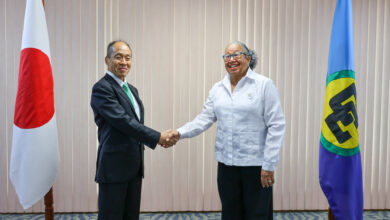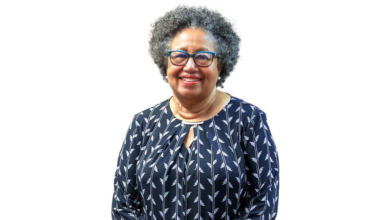It is my pleasure to bring you greetings on behalf of the Secretary-General and staff of the Caribbean Community Secretariat and indeed the entire CARICOM family.
This eighth CARIFESTA has already brought its fair share of excitement and expectations, challenges and creative adaptations, frustrations and a spirit of accommodation and understanding. After all, this festival is taking place in the Southern most Member State of the CARICOM family, whose ancestral heritage adds a distinctive flavour to the cultural variation that makes this region of ours so uniquely diverse and illustrates how many cultures can indeed coalesce to enflame the essence of the Caribbean spirit; this Caribbean spirit is and will ever be kept alive by our artists, poets, writers, painters, dancers, musicians, crafts persons and culinary practitioners. Yet we continue to hear their concerns about the deficiencies of the environment in which they practice their crafts, the lack of tangible resources, the lack of appreciation for their worth, and even the disregard for their contribution to the essence of national development and regional integration.
Over the years, many statements have been made by officials and others about this state of affairs. Many promises go unfulfilled. Yet it is evident that the fruits of our cultural workers continue to survive and continue to make a mark on the world’s stage. We owe it to this region to nurture the seeds of our creative talents and ensure greater sustainability of our cultural products and rewards to our cultural producers.
In this respect, this series of symposia is most important. It focuses particularly on how to improve the environment of our cultural workers and how to enrich the value of their work. This segment undertakes to look to a constructive future. But in doing so it requires some reflection on the gaps, the needs, and the inequities. It also requires building of creative structures and fashioning processes that allow the artists and the artistes full scope for expression of their creative imagination and the opportunities to excel even beyond our imagination.
We who stay close to the arts know that they take us into unknown spaces. They jolt our senses. They ignite our sensibilities. They interpret our fears, yet they bring us joy. They provide the parody in our being, yet transcend reality. And for this reason I agree with the wisdom of Leroy Clarke at the opening of the honorary exhibitions at this CARIFESTA when he characterized the qualities of genuine artists and artistes as those that engender fear on the part of bureaucrats in traditional official quarters because of the unexpected outcomes of their creativity.
This particular segment of the symposia is intended to deal with the kinds of structures, processes and organizations that can best promote this creativity of our cultural workers. And this takes on new meaning in this present era in which we live. It takes on a greater urgency in view of the rapidly changing world in which technology and e-commerce are becoming so pervasive that they provide a threat to even the most creative genius, if it fails to recognize the need for order and structure.
The problem is how to achieve this ordering and restructuring of culture and the arts without eroding the creative talents.
Research, documentation and networking
It seems reasonable to assume that at the heart of such order and restructuring is the need to pay attention to research and documentation of our unique art forms without which our rich heritage would either be lost to posterity or be absorbed or simply high-jacked by those who invest in such activities. Hence it is important that we pay attention to the networks for publishing, projecting the visual arts, development of databases and other resources that sustain cultural products.
Training and Development
It seems reasonable to assume that greater investment must be placed in the avenues for training, harnessing and producing talent, through exposure to role models, masters of the arts, purveyors of our cultural traditions, critics and critiques of the various crafts. We also need to institutionalize opportunities for sharing and documenting experiences that help advance techniques, stimulate the incorporation of new techniques and technologies and help stimulate excellence.
Management
It also seems reasonable to assume that achieving excellence requires placing greater emphasis on management of our cultural resources especially in the era when globalization is redefining our approaches to trade in services, intellectual property rights, making it essential for our small countries in this region to evolve and negotiate policies on the international stage to ensure that our cultural competitiveness is not negated. In this context, there is need for a partnership among the government and the private sector and the cultural workers as a group.
It seems most reasonable to assume also that there is now more than ever, the need for change management in the marketing and promotion of our cultural products. It is a process that requires new perspectives on the part of both government and sponsors of art on the one hand and the cultural workers on the other. Too often the artists or writer becomes stuck in the past and refuses to embrace the challenges and opportunities of a future world. Too often, however, are the policy makers and politicians blind-sided by the exigencies of economics and the liberalization of trade to pay due attention to the insights of our painters and writers as they try to expose the soul of our economies.
The aesthetics of our dilemmas
These are dilemmas to which many of our writers like Wilson Harris and CLR James allude. But they are dilemmas for which we must find solutions. Hopefully our expert panelists today and tomorrow will help us to truly go beyond the boundary to craft an agenda, a viable agenda that is for culture and arts in the Caribbean. Hopefully our presenters would take bold but realistic steps that would truly help us to fashion sound policies on which to build sustainable resources such as the long awaited Caribbean Foundation for the Culture and the Arts. These are all aspects of creating aesthetics out of our dilemmas.
The Future
In discussion with the Honorable Walter Sandriman, Minister of Education and Community Development, Chairman of the CARIFESTA VIII Committee and even more important, Chairman of the Council for Human and Social Development, CARICOM, is resolved that the recommendations from this symposium be discussed at COHSOD IX to be held in Georgetown in October 8-10 and that the proposal for action be taken to the Intersessional meeting of Heads of Government to be held in Antigua and Barbuda in February/March 2004.
In this regard, this series of symposia takes on a different meaning and a different dynamic. We here at Torarica in Paramaribo, at this CARIFESTA VIII, have a destiny with history. It is a destiny that could forever determine the invincibility or otherwise of our cultural products. In the spirit of our cultural heroes, let our discussions be harnessed by the realities of our present environment. Let us be conscious that as we forge our programmes for the future, we are at the cross roads of a new beginning in our regional integration process. It is a process in which our cultural workers are destined to play a critical role.
We here today must see our role as influencing the course of a bright and radiant future for culture and the arts.





